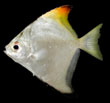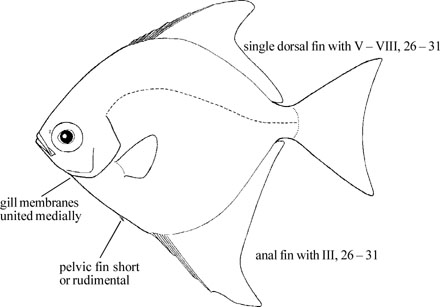MONODACTYLIDAE
Moonyfishes (fingerfishes)
By Ukkrit Satapoomin
 Monodactylus argenteus |
|
|
Body oval, deep and highly compressed (size to about 25 cm). Eye moderately large, its diameter longer than snout length. Mouth small and oblique. Jaws with bands of small conical teeth; vomer, palatines, and tongue with granular teeth. Gill membranes free from isthmus; branchiostegal rays 6. Dorsal fin with the base long and scaly, V - VIII short spines and 26 - 31 soft rays; anterior soft dorsal fin rays elongated, situated over midlength of body; anal fin base long, with III spines and 26 - 31 soft rays; anterior soft anal fin rays elongated, situated over midlength of body; caudal fin truncate to forked. Scales cycloid or ctenoid. Color: often silvery with 1 or more black vertical bar through eye, in front of pectoral fin base and on body; tip of dorsal an anal fins black in most species.
Similar families occurring in the area. Drepanidae and Ephippidae: pelvic fins well developed; gill membranes attach to isthmus. Chaetodontidae and Scatophagidae: pelvic fins well developed; dorsal fin with X - XVII spines; spinous part of dorsal fin well separated from soft rayed part. Carangidae: caudal fin forked; anal fin with II spines. Menidae: ventral profile conspicuously more convex than dorsal profile; caudal fin forked; dorsal fin without spines in adults; first 2 pelvic fin rays elongated. Remarks. Occur in shoals in estuaries and over shallow coral reefs, occasionally entering freshwater. Feed on small fish and invertebrates. The family name derived from Greek, monos = only + Greek, daktylos = finger. |

|
|